Old masonry has been decaying since it is no longer needed and nobody has been taking care of it for a long time. The castle ruins at Alt-Ems have been properly torn down – during the redevelopment period of several houses in Marktstraße, Hohenems, stones originally from the castle walls were found. Now, during the redevelopment of the ruins, some of them have been returned to the castle hill. However, that is another story which starts in the early Middle Ages and which demonstrates the cultural importance of the small town at the foot of the castle hill.
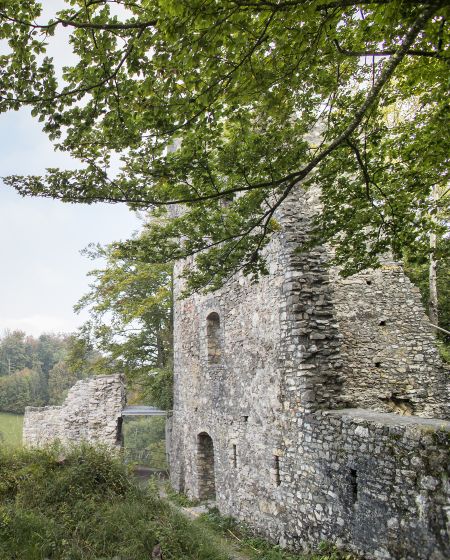
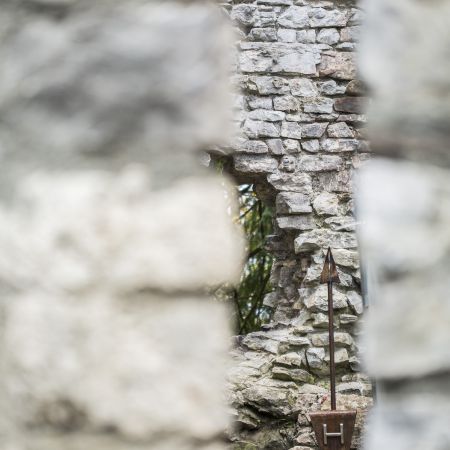
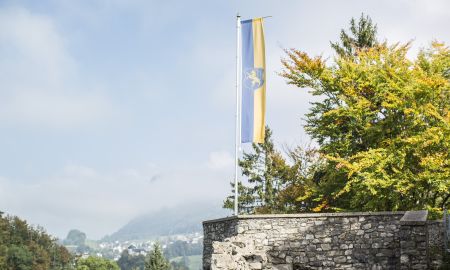
Legend and the 21st century
The first settlers to arrive in Hohenems were the Walsers in Emsreute when they migrated there via the mountain village of Ebnit. The fortress of Alta-Ems – Alta-Embs, i.e. High Embs – was built above the settlement. The castle, first owned by the Welfs and then the Staufers (the first clues date back to the year 900), was one of the biggest castle complexes in Central Europe with its seven gates, a drawbridge and 47 rooms. Its eventful history is shrouded in legends and miracles. The famous world chronicle of Rudolf von Ems originates back to the castle, two manuscripts from the Nibelungenlied were discovered in Hohenems palace in the 18th century and the fortress was the sad home to several famous prisoners. It is said that, still a child, Saint Konrad took pity on the thirsty workers working on a wall, and he brought them water in a handkerchief to the castle keep. When he spilled it, a spring arose at the place he spilled the water. Later, a well developed there – the famous Konradsbrunnen. So much for the legend about the Welf child who later on was canonised as the Bishop of Constance. Reality is less romantic, as revealed recently during archaeological excavations: the Konradsbrunnen is a cistern which used a secondary shaft lined with clay in order to have flow into the cistern the water that has been at least slightly filtered through the gravel fill on its soil. The spirit of the 21st century knows no mercy when it comes to saints and their miracles.
Happy historians
“The current redevelopment works started in 2005, and were preceded by long negotiations. The chairman of Hohenems tourist promotion agency at the time, Richard Mathis, set things in motion. The objective was to keep the stones on site of the castle – where they belong,” says Dieter Heidegger, the successor of Richard Mathis and project manager of the redevelopment works at the castle ruins.
“We made two sensational finds in the summer of 2014,” he reports. “This was a real stroke of luck for the historians in our team of experts. We cooperate with the Bauakademie Hohenems, which is attended by all of Vorarlberg’s apprentice bricklayers. They learn the preservation of historic masonry from our castle master builder Raimund Rhomberg. In the summer, they uncovered an as-yet unknown wall from the 12th century – it even contains a well-preserved piece of indoor plastering. The discovery of this wall resulted in the castle being surveyed anew – the plans will have to be adapted accordingly, especially since a new entrance was discovered. It is imaginable that a completely different ground-plan existed at the start of construction of the castle, something which construction historian Raimund Rhomberg finds very exciting. Since then, whenever he and Harald Rhomberg, the chairman of the castle committee at the Vorarlberger Landesmuseumsverein (founded in 1857), work on the castle, their eyes light up. The finds are multiplying: “A short time later, we unearthed an iron door hinge. It is 450 years old, and now it is affixed such that it can be viewed in its original place and position. “Naturally, there are no such things as building plans – the only thing we can use as a basis are old paintings which give a surprisingly accurate image of that which, once upon a time, sat enthroned above Hohenems. The castle suffered extensive damage during the Appenzeller Wars. Following the death of the Counts of Hohenems, the castle passed over to Austria in 1765, and in 1792 it was decided to demolish the castle, explaining the stones in Marktgasse in Hohenems. Today, the ruins are privately owned by the Waldburg-Zeil family, which lives in the renaissance palace directly below the ruins. The well-preserved Glopper castle, built later, is also owned by the family, which preserves and redevelops sufficiently historically valuable buildings – a reason for the friendly approval for the redevelopment of the castle ruin and the promise that they will still be open to the public free of charge. The redevelopment work is being financed by the Bundesdenkmalamt, the state of Vorarlberg, the town of Hohenems, an aid association and donations.
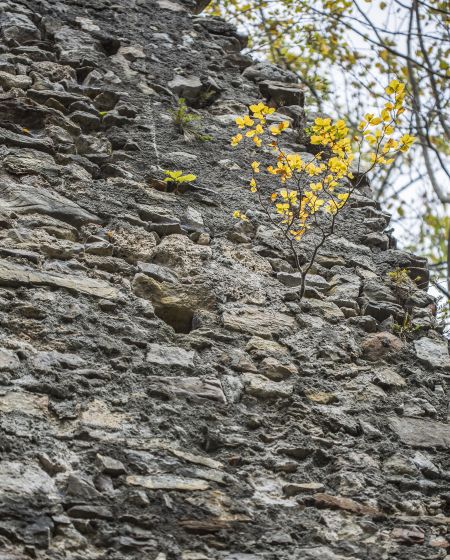
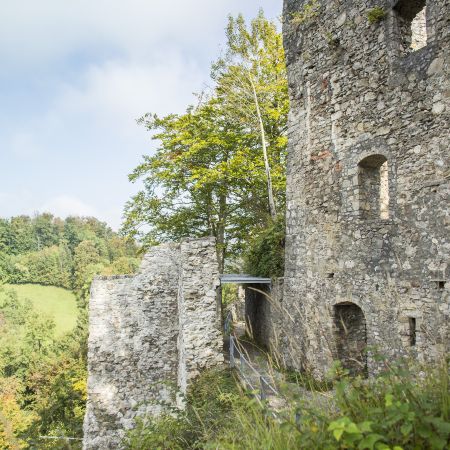
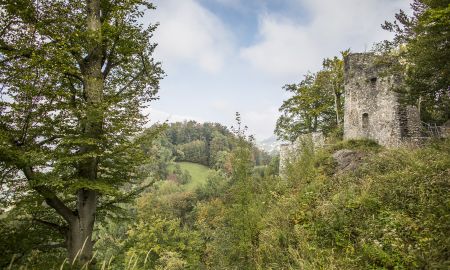
Time is running out
The decay is progressing week by week, and some of the walls would not have survived the winter but for the team’s efforts. First of all, three interior walls were strengthened and reinforced. The team works according to a list of priorities and they do whatever is humanly possible – however, the walls are already decimated such that the decay is already seriously advanced. An archaeological find was also recently made: a ditch 10 metres in length, 50 cm wide and deep revealed layers enabling historians to read it like a coded book. The finds included a hand grenade from the 16th century, a clasp from a chain and suchlike. “However, we are not there to be archaeologists, but rather to save the castle walls,” emphasises Dieter Heidegger. To this end, the imaginative marketing specialist is drawing up a cultural programme to attract as many visitors as possible to the historic castle. “The more people that come to Hohenems, the better it is for the castle ruins. It goes without saying that there isn’t enough money available for such a project, and we won’t be able to save all the walls that are still standing today. The two turrets (round rooms made of brick) are extremely rare in Vorarlberg. We have just had to close them off due to the danger of falling rocks, but we are full of confidence. ”And so there have been – and there will be – exhibitions, concerts and readings in what is left of the romantic walls, guided tours will be held based on donations for the redevelopment fund, and groups of schoolkids with the book of legends can frequently be found occupying the Konradsbrunnen after such a guided tour, trying to work out where the missing, golden skittles could be found. Another one of the numerous legends about the castle ruins of Alt-Ems which, hopefully, will never reveal their secret.

